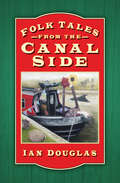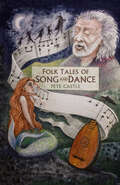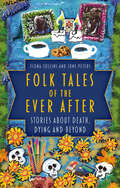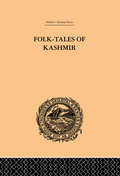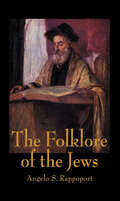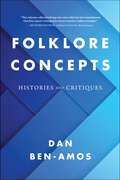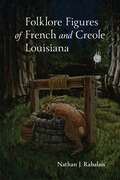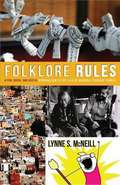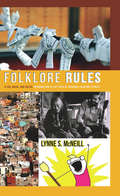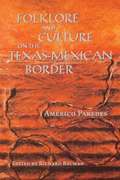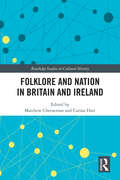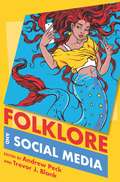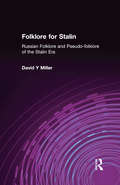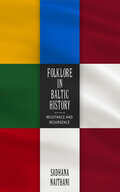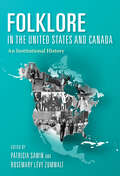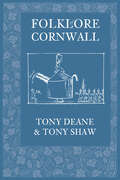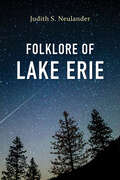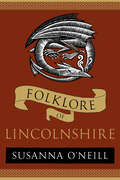- Table View
- List View
Folk Tales from the Canal Side
by Ian DouglasTwisting and turning its way through great cities and towns is the eternal navigation: a network of canals that fed the industrial growth of our country. Nowadays we might consider our waterways a place to find peace and relaxation, but under that tranquil surface hides a turbulent past.Storyteller and narrowboat dweller Ian Douglas has salvaged a wealth of stories from the depths. Murder and mystery, heroes and love, devils and oatcakes are all wrapped up in this wonderful book – but beware … you will never see the towpath in the same way again!
Folk Tales of Song and Dance (Folk Tales)
by Pete Castle?The life of the travelling musician hasn't changed much over the millennia. For a prehistoric harper, a medieval fiddler or a modern guitar player, the experience is pretty much the same: there are times when everything goes well and others when nothing does.But it's not just performing that can go wrong – listening can also be dangerous! Can you stop dancing when you get tired or must you keep going until the music stops … if it ever does? What happens if it carries on past midnight? What if it turns you to stone?Pete Castle has selected a variety of traditional tales from all over the UK (and a few from further afield) to enthral you, whether you are a musician, a dancer, or a reader who likes to keep dangerous things like singing and dancing at arm's length.
Folk Tales of the Ever After: Stories about Death, Dying and Beyond
by Fiona Collins June PetersThere is a time and a season to all things, and death is an inevitable part of the circle of life.Oral traditions from all over the world are full of stories giving shape to the very human wish to defy death – our own death and the deaths of others. Folk Tales of the Ever After is a collection of traditional tales from a range of cultures which is, by turns, funny, challenging and touching.From a man in Baghdad who tries to outrun Death, to Sir Lancelot’s ride on the hangman’s cart and an Ancient Sumerian ball game that leads to a trip to the underworld, storytellers Fiona and June invite you to share stories from their repertoire, and insights into their working practice, as a journey through the mysteries of death, dying,bereavement, loss, grief and the ever after.
Folk Theatres of North India: Contestation, Amalgamation and Transference
by Karan SinghThis book examines folk theatres of North India as a unique performative structure, a counter stream to the postulations of Sanskrit and Western realistic theatre. In focusing on their historical, social and cultural imprints, it explores how these theatres challenge the linearity of cultural history and subvert cultural hegemony. The book looks at diverse forms of theatre such as svangs, nautanki, tamasha, all with conventions like open performative space, free mingling of spectators and actors, flexibility in roles and genres, etc. It discusses the genesis, history and the independent trajectory of folk theatres; folk theatre and Sanskrit dramaturgy; cinematic legacy; and theatrical space as performance besides investigating causes, inter-relations within socio-cultural factors, and the performance principles underlying them. It shows how these theatres effectively contest delimitation of human creative impulses (as revealed in classical Sanskrit theatre) from structuring as also of normative impulses of religion and culture, while amalgamating influences from Western theatre, newly-rising religious reform movements of 19th century India, tantra and Bhakti. It further highlights their ability to adapt and reinvent themselves in accordance with spatial and temporal transformations to constitute an important anthropological layer of Indian society. Comprehensive and empirically rich, this book will be an essential read for scholars and researchers of cultural studies, theatre, film and performance studies, sociology, political studies, popular culture, and South Asian studies.
Folk-Tales of Kashmir (Trubner's Oriental Ser.)
by J. Hinton KnowlesFirst Published in 2000. Routledge is an imprint of Taylor & Francis, an informa company.
Folklare Of The Jews
by RappoportFirst published in 2007. Routledge is an imprint of Taylor & Francis, an informa company.
Folklinguistics and Social Meaning in Australian English (Routledge Studies in World Englishes)
by Cara Penry WilliamsFolklinguistics and Social Meaning in Australian English presents an original study of Australian English and, via this, insights into Australian society. Utilising folklinguistic accounts, it uncovers everyday understandings of contemporary Australian English through variations across linguistic systems (sounds, words, discourse and grammar). Focusing on one variation at time, it explores young speakers’ language use and their evaluations of the same forms. The analysis of talk about talk uncovers ethnic, regional and social Others in social types and prevailing ideologies around Australian English essential for understanding Australian identity-making processes, as well as providing insights and methods relevant beyond this context. These discussions demonstrate that while the linguistic variations may occur in other varieties of English, they are understood through local conceptualisations, and often as uniquely Australian. This book harnesses the value and richness of discourse in explorations of the sociocultural life of language. The findings show that analysis attending to language ideologies and identities can help discover the micro–macro links needed in understanding social meanings. The volume explores a wide range of language features but also provides a deep contemplation of Australian English.
Folklore Concepts: Histories and Critiques
by Dan Ben-AmosBy defining folklore as artistic communication in small groups, Dan Ben-Amos led the discipline of Folklore in new directions. In Folklore Concepts, Henry Glassie and Elliott Oring have curated a selection of Ben-Amos's groundbreaking essays that explore folklore as a category in cultural communication and as a subject of scholarly research. Ben-Amos's work is well-known for sparking lively debate that often centers on why his definition intrinsically acknowledges tradition rather than expresses its connection forthright. Without tradition among people, there would be no art or communication, and tradition cannot accomplish anything on its own—only people can. Ben-Amos's focus on creative communication in communities is woven into the themes of the theoretical essays in this volume, through which he advocates for a better future for folklore scholarship. Folklore Concepts traces Ben-Amos's consistent efforts over the span of his career to review and critique the definitions, concepts, and practices of Folklore in order to build the field's intellectual history. In examining this history, Folklore Concepts answers foundational questions about what folklorists are doing, how they are doing it, and why.
Folklore Figures of French and Creole Louisiana
by Nathan RabalaisIn Folklore Figures of French and Creole Louisiana, Nathan J. Rabalais examines the impact of Louisiana’s remarkably diverse cultural and ethnic groups on folklore characters and motifs during the eighteenth and nineteenth centuries. Establishing connections between Louisiana and France, West Africa, Canada, and the Antilles, Rabalais explores how folk characters, motifs, and morals adapted to their new contexts in Louisiana. By viewing the state’s folklore in the light of its immigration history, he demonstrates how folktales can serve as indicators of sociocultural adaptation as well as contact among cultural communities. In particular, he examines the ways in which collective traumas experienced by Louisiana’s major ethnic groups—slavery, the grand dérangement, linguistic discrimination—resulted in fundamental changes in these folktales in relation to their European and African counterparts.Rabalais points to the development of an altered moral economy in Cajun and Creole folktales. Conventional heroic qualities, such as physical strength, are subverted in Louisiana folklore in favor of wit and cunning. Analyses of Black Creole animal tales like those of Bouki et Lapin and Tortie demonstrate the trickster hero’s ability to overcome both literal and symbolic entrapment through cleverness. Some elements of Louisiana’s folklore tradition, such as the rougarou and cauchemar, remain an integral presence in the state’s cultural landscape, apparent in humor, popular culture, regional branding, and children’s books. Through its adaptive use of folklore, French and Creole Louisiana will continue to retell old stories in innovative ways as well as create new stories for future generations.
Folklore Recycled: Old Traditions in New Contexts
by Frank de CaroFolklore Recycled: Old Traditions in New Contexts starts from the proposition that folklore—usually thought of in its historical social context as “oral tradition”—is easily appropriated and recycled into other contexts. That is, writers may use folklore in their fiction or poetry, taking plots, as an example, from a folktale. Visual artists may concentrate on depicting folk figures or events, like a ritual or a ceremony. Tourism officials may promote a place through advertising its traditional ways. Folklore may play a role in intellectual conceptualizations, as when nationalists use folklore to promote symbolic unity.Folklore Recycled discusses the larger issue of folklore being recycled into nonfolk contexts and proceeds to look at a number of instances of repurposing. Colson Whitehead’s novel John Henry Days is a literary text that recycles folklore but does so in a manner that examines a number of other uses of the American folk figure John Henry. The nineteenth-century members of the Louisiana branch of the American Folklore Society and the author Lyle Saxon in the twentieth century used African American folklore to establish personal connections to the world of the southern plantation and buttress their own social status. The writer Lafcadio Hearn wrote about folklore to strengthen his insider credentials wherever he lived. Photographers in Louisiana leaned on folklife to solidify local identity and to promote government programs and industry. Promoters of “unorthodox” theories about history have used folklore as historical document. Americans in Mexico took an interest in folklore for acculturation, for tourism promotion, for interior decoration, and for political ends. All of the examples throughout the book demonstrate the durability and continued relevance of folklore in every context it appears.
Folklore Rules
by Lynne S. McneillFolklore Rules is a brief introduction to the foundational concepts in folklore studies for beginning students. Designed to give essential background on the current study of folklore and some of the basic concepts and questions used when analyzing folklore, this short, coherent, and approachable handbook is divided into five chapters: What Is Folklore?; What Do Folklorists Do?; Types of Folklore; Types of Folk Groups; and, finally, What Do I Do Now?Through these chapters students are guided toward a working understanding of the field, learn basic terms and techniques, and learn to perceive the knowledge base and discourse frame for materials used in folklore courses. Folklore Rules will appeal to instructors and students for a variety of courses, including introductory folklore and comparative studies as well as literature, anthropology, and composition classes that include a folklore component.
Folklore Rules: A Fun, Quick, and Useful Introduction to the Field of Academic Folklore Studies
by Lynne S. McNeillFolklore Rules is a brief introduction to the foundational concepts in folklore studies for beginning students. Designed to give essential background on the current study of folklore and some of the basic concepts and questions used when analyzing folklore, this short, coherent, and approachable handbook is divided into five chapters: What Is Folklore?; What Do Folklorists Do?; Types of Folklore; Types of Folk Groups; and, finally, What Do I Do Now? Through these chapters students are guided toward a working understanding of the field, learn basic terms and techniques, and learn to perceive the knowledge base and discourse frame for materials used in folklore courses. Folklore Rules will appeal to instructors and students for a variety of courses, including introductory folklore and comparative studies as well as literature, anthropology, and composition classes that include a folklore component.
Folklore Studies of Traditional Chinese House-Building
by Shiwu LiThis book provides extensive information on craftsmen-built houses in China. Though some inroads have been made in studying this folk custom, this work represents the first comprehensive and systematic monograph. The book examines the topic at the two main levels of “history” and “theory”. Combining historical textual research, contemporary textual research, and field study, the book presents systematic information on the folk custom of craftsmen-built houses in China. At the level of theoretical research, it puts forward some original opinions on the major theoretical issues, such as the folk custom of religious belief, the boundary between superstition and religion, and the relationship between oral literature and ritual. The book provides a guide to help readers systematically understand the folk custom of craftsmen-built houses in China. Sharing valuable insights into Chinese architectural history, as well as religious studies, cultural anthropology, and folklore, it will appeal to researchers in the fields of folklore, cultural anthropology, and architecture and can also serve as a popular science book for understanding Chinese architectural culture.
Folklore and Culture on the Texas-Mexican Border
by Americo Paredes Richard BaumanThe editor Richard Bauman has selected eleven scholarly essays that eloquently represent the range and excellence of Paredes's work.
Folklore and Folklife in the United Arab Emirates (Culture and Civilization in the Middle East)
by Sayyid Hamid HurriezA unique description and analysis of the domains and genres of UAE folklore, including folk customs and beliefs, traditional arts and crafts, folk dances, folk narratives and proverbs. Challenging the established meaning of folklife, this volume also deals with folklore in public life, in the mass media, in education and in politics.
Folklore and Nation in Britain and Ireland (Routledge Studies in Cultural History)
by Matthew Cheeseman; Carina HartThis collection explores folklore and folkloristics within the diverse and contested national discourses of Britain and Ireland, examining their role in shaping the islands’ constituent nations from the eighteenth century to our contemporary moment of uncertainty and change. This book is concerned with understanding folklore, particularly through its intersections with the narratives of nation entwined within art, literature, disciplinary practice and lived experience. By following these ideas throughout history into the twenty-first century, the authors show how notions of the folk have inspired and informed varied points from the Brothers Grimm to Brexit. They also examine how folklore has been adapting to the real and imagined changes of recent political events, acquiring newfound global and local rhetorical power. This collection asks why, when and how folklore has been deployed, enacted and considered in the context of national ideologies and ideas of nationhood in Britain and Ireland. Editors Cheeseman and Hart have crafted a thoughtful and timely collection, ideal for students and scholars of folklore, history, literature, anthropology, sociology and media studies.
Folklore and Social Media
by Trevor J. Blank Andrew PeckTen years after the publication of the foundational edited collection Folklore and the Internet, Andrew Peck and Trevor J. Blank bring an essential update of scholarship to the study of digital folklore, Folklore and Social Media. A unique virtual, hybridized platform for human communication, social media is more dynamic, ubiquitous, and nuanced than the internet ever was by itself, and the majority of Americans use it to access and interact with digital source materials in more advanced and robust ways. This book features twelve chapters ranging in topics from legend transmission and fake news to case studies of memes, joke cycles, and Twitter hashtag campaigns and offers fresh insights on digital heritage and web archiving. The editors and contributors take both the “digital” and “folklore” elements seriously because social media fundamentally changes folk practices in new, though often invisible, ways. Social media platforms encourage hybrid performances that appear informal and ordinary while also offering significant space to obfuscate backstage behaviors through editing and retakes. The result is that expression online becomes increasingly reminiscent of traditional forms of face-to-face interaction, while also hiding its fundamental differences. Folklore and Social Media demonstrates various ways to refine methods and analyses in order to develop a better understanding of the informal and traditional dynamics that define an era of folklore and social media. It is an invaluable addition to the literature on digital folklore scholarship that will be of interest to students and scholars alike. Contributors: Sheila Bock, Peter M. Broadwell, Bill Ellis, Jeana Jorgensen, Liisi Laineste, John Laudun, Linda J. Lee, Lynne S. McNeill, Ryan M. Milner, Whitney Phillips, Vwani Roychowdhury, Timothy R. Tangherlini, Tok Thompson, Elizabeth Tucker, Kristiana Willsey
Folklore and the Internet
by Trevor J. BlankA pioneering examination of the folkloric qualities of the World Wide Web, e-mail, and related digital media. These stuidies show that folk culture, sustained by a new and evolving vernacular, has been a key, since the Internet's beginnings, to language, practice, and interaction online. Users of many sorts continue to develop the Internet as a significant medium for generating, transmitting, documenting, and preserving folklore. In a set of new, insightful essays, contributors Trevor J. Blank, Simon J. Bronner, Robert Dobler, Russell Frank, Gregory Hansen, Robert Glenn Howard, Lynne S. McNeill, Elizabeth Tucker, and William Westerman showcase ways the Internet both shapes and is shaped by folklore
Folklore and the Internet: Vernacular Expression in a Digital World
by Trevor J. BlankA pioneering examination of the folkloric qualities of the World Wide Web, e-mail, and related digital media. These stuidies show that folk culture, sustained by a new and evolving vernacular, has been a key, since the Internet's beginnings, to language, practice, and interaction online. Users of many sorts continue to develop the Internet as a significant medium for generating, transmitting, documenting, and preserving folklore. In a set of new, insightful essays, contributors Trevor J. Blank, Simon J. Bronner, Robert Dobler, Russell Frank, Gregory Hansen, Robert Glenn Howard, Lynne S. McNeill, Elizabeth Tucker, and William Westerman showcase ways the Internet both shapes and is shaped by folklore
Folklore for Stalin: Russian Folklore and Pseudo-folklore of the Stalin Era
by Frank J. MillerAfter the First Congress of Soviet Writers in 1934, folklore, like literature, became an instrument of the political propagandist. Folklorists devoted considerable efforts to attending to what purported to be a rebirth of the Russian epic tradition, producing works of pseudofolklore that as often as not featured Joseph Stalin in the hero's role. Miller's account of this curious episode in the history of popular culture and totalitarian politics, and his synopses and translations of "classic" examples of folklore for Stalin, seek to serve as a resource not only for the study of contemporary folklore but also for the political scientist.
Folklore in Baltic History: Resistance and Resurgence
by Sadhana NaithaniFolklore in the Baltic History: Resistance and Resurgence is about the role of folklore, folklore archives, and folklore studies in the contemporary history of Estonia, Latvia, and Lithuania—together called the Baltic countries. They were occupied by Russia, by Germany, and lastly by the USSR at the end of the Second World War. They regained freedom in 1991.The period under the rule of the USSR brought several changes to their societies and cultures. Individuals and institutions dealing with folklore—archives, university departments, and folklorists—came under special control, attack, and surveillance. Some of the pioneer folklorists escaped to other countries, but many others witnessed their institutions and the meaning of folklore studies transformed. The USSR did not stop folklore studies but led the field to new methods. In spite of all the pressure, folklore continued to be a matter of identity, and folksongs became the marching songs of crowds resisting Soviet control in the late 1980s. Since independence in 1991, folklore scholars and institutions revamped and reconstituted folkloristics. Today all three countries have many active scholars and institutions.Sadhana Naithani recounts this resilient arc through an intermedial and interdisciplinary methodology of research. She combines the study of written works, archival documents, life-stories, and conversations with folklorists, ethnologists, archivists, and historians in Tartu, Riga, and Vilnius. She recorded conversations on video, creating current reflections on issues of the recent past. Based on the study of life-stories and oral history projects, Naithani juxtaposes the history of folkloristics and the life of the folk in the Soviet period of the Baltic countries. The result is this dramatic, first-ever history of Baltic folkloristics.
Folklore in the United States and Canada: An Institutional History
by Patricia Sawin and Rosemary Lévy ZumwaltTo ensure continuity and foster innovation within the discipline of folklore, we must know what came before. Folklore in the United States and Canada is an essential guide to the history and development of graduate folklore programs throughout the United States and Canada. As the first history of folklore studies since the mid-1980s, this book offers a long overdue look into the development of the earliest programs and the novel directions of more recent programs. The volume is encyclopedic in its coverage and is organized chronologically based on the approximate founding date of each program. Drawing extensively on archival sources, oral histories, and personal experience, the contributors explore the key individuals and central events in folklore programs at US and Canadian academic institutions and demonstrate how these programs have been shaped within broader cultural and historical contexts. Revealing the origins of graduate folklore programs, as well as their accomplishments, challenges, and connections, Folklore in the United States and Canada is an essential read for all folklorists and those who are studying to become folklorists.
Folklore of Cornwall
by Tony Shaw Tony DeaneStanding alone at the bottom tip of England and despite the enormous influx of tourists it receives each year, Cornwall boasts many unique traditions. This volume touches on the wide variety of legends, songs and stories and their relationship with the rugged landscape: from standing stones and tales of sea-monsters and mermaids to ghosts, fairies and giants. The book looks at pagan ceremonies and old traditions, and the very Cornish love of singing. It further discusses the Cornish tongue, and the old language of Cornwall. And, of course, no study of Cornwall would be complete without some consideration of King Arthur and his legacy upon the folklore of the county.
Folklore of Lake Erie
by Judith S. NeulanderWelcome to a very different Lake Erie—where ghost ships sail silently, a Black Dog brings doom to sailors who see it, and sea monsters swirl in the murky depths above a UFO base. In Folklore of Lake Erie, Judith S. Neulander presents these captivating tales and many more from the smallest, yet arguably the most peculiar, of the Great Lakes in North America.Whether you are embarking on a discovery of the vampire crypt that lurks in the shadows while Lincoln's ghost train speeds past on its eternal journey or reminiscing about the tall tales your grandfather used to share, this delightful treasure trove of folklore and local traditions from the Lake Erie region contains legends and stories that are both astonishing and entertaining.Endlessly captivating and easily accessible, Folklore of Lake Erie is a distinctive compilation of eerie and enchanting narratives from across the years that will surprise and delight readers. Just be sure to keep an eye out for any peculiar Black Dogs that may cross your path along the way.
Folklore of Lincolnshire (Folklore)
by Susanna O'NeillThe county of Lincolnshire is a beautiful mixture of low-lying marshy fen land, modest hills and the steep valleys of the rolling Wolds. It is also home to a wealth of folklore, legend and intrigue. With one of the most interesting dialects in the country, this vast region is also rich in superstitions, songs and traditional games.A study of the daily life, lore and customs of Lincolnshire are here interspersed with stories of monstrous black hounds, dragon lairs, witches, Tiddy Mun, mischievous imps and tales of the people known as Yellowbellies. This fully illustrated book explores the origins and meanings of Lincolnshire’s traditions and shows how the customs of the past have influenced the ways of the present.
